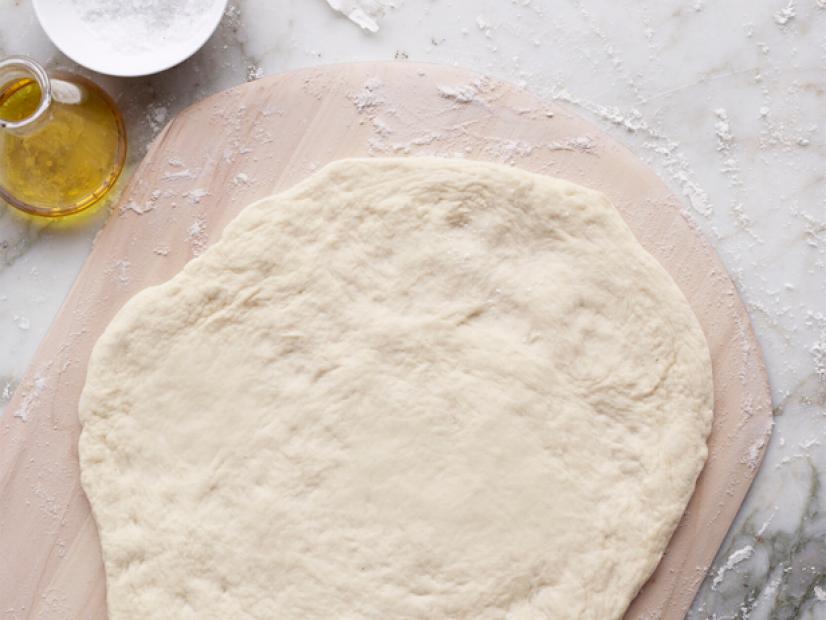How to Make Pizza Dough
The test kitchen at Food Network brings you a foolproof recipe and a concise, smart primer on DIY-ing pizza dough at home.

- Nutritional Analysis
- Per Serving
- Serving Size
- 1 of 2 servings
- Calories
- 1114
- Total Fat
- 24 g
- Saturated Fat
- 3 g
- Carbohydrates
- 192 g
- Dietary Fiber
- 11 g
- Sugar
- 7 g
- Protein
- 31 g
- Cholesterol
- 0 mg
- Sodium
- 648 mg
Article by Emily Saladino
Once you learn how to make pizza dough, you’ll be hard pressed to buy those plastic-wrapped balls from the freezer case. Entire books have been written about pizza dough making, but the recipe developers at Food Network have distilled their very best tips into a bite-sized primer.
How to Make Pizza Dough: Our Kitchen’s Top Tips
What’s the Best Flour for Pizza Dough? Our recipe developers use all-purpose flour to make pizza dough because it’s affordable, accessible and can be used to make thin or thick pizza crusts. It all comes down to protein content: All-purpose flours contain a moderate (9 to 11%) amount of protein. In breads and doughs, the higher the protein, the more gluten can develop. Doughs that contain lots of well-developed gluten are stronger and more durable than those made with low-protein flours such as cake flour. If you prefer your pizzas with thin, chewy crusts, swap the all-purpose flour for an equal amount of bread flour. The latter has higher protein content and will develop even more gluten, meaning it maintains its shape and doesn’t tear as easily when it’s stretched.
How to Knead Pizza Dough: Kneading strengthens the gluten network in your dough, so you’ll be able to stretch it without tearing. Here’s how our recipe developers do it.
Place the dough on a clean, lightly floured surface. Use enough flour to keep it from sticking but not so much that it dries out or changes the consistency of the dough.
Push away from you and rotate. Use the heel of your hand to push the dough down and away from you, then turn it 45 degrees. Repeat, adding more flour if the dough starts to cling.
Knead for 4 to 5 minutes. The dough is ready when it looks smooth and feels a little tacky. Stop once you’ve reached that lightly sticky consistency; over-kneading can lead to stiff, chewy crust.
Get precise and track your dough’s rise. The rise is crucial because it gives the yeast, flour and water the time they need to develop enough gluten to create a perfectly stretchable pizza crust. Depending on the temperature and humidity of your kitchen, homemade pizza dough may need anywhere from one to two hours to rise; you can also put it overnight in the fridge. To chart your progress, use a marker to trace the outline of the dough ball on the plastic wrap on top of the greased bowl.
Frozen dough lasts up to 1 month. Pizza dough keeps beautifully in the freezer. To freeze it, tightly wrap the dough ball in plastic and store it in the freezer for up to 1 month. To defrost it, put the frozen dough in the refrigerator overnight. Let the dough rest at room temperature for at least 30 minutes before starting your pizza recipe.
How to Stretch Pizza Dough
Stretch pizza dough wrong, and you can end up with cardboard-like, brittle results, negating all that hard work that went into making the dough. Here’s how to properly stretch it.
Prepare the pan or peel. Sprinkle your pizza pan or peel with a pinch of semolina to keep it from sticking and create texture and crunch after it’s baked.
Spread it along the outer perimeter. Place the dough ball in the center of the pan or peel and use your fingertips to spread it out. Work along the outer perimeter of the dough, lightly pushing it away from you. Working from the outer edge rather than the center keeps it from over-stretching or becoming brittle in the oven. If the dough bounces back immediately, let it rest another 5 to 10 minutes at room temperature.
Spin and repeat. Rotate the pizza pan or peel and continue pushing outward from the outer edge until it’s evenly thick and covers your pan or peel.
How to Make Pizza with Homemade Dough
Shape the dough. Slide your hands under the dough to stretch it to fit a 14-inch pizza steel or sheet pan that’s been brushed with oil (it’s OK if it doesn’t reach the four corners of the pan).
Top the dough. Spread the sauce with a pastry brush or back of a large spoon, then add cheese and whichever toppings you prefer.
Preheat the stone or baking sheet. If you’re cooking your pizza on top of a pizza stone or baking sheet, let it sit in the preheated oven for at least 15 minutes and up to an hour before you slide the pizza into the oven.
Cook the dough. Most pizzas are cooked for approximately 8 to 15 minutes at 450 to 500 degrees Fahrenheit, though exact timing and the best oven temperature for pizza depend on how thick you make the crust and type of pan you cook it in.
Uses for Homemade Pizza Dough
This easy pizza dough recipe produces two rounds, so you can make multiple pizzas or use them in various savory or sweet recipes. Use this pizza crust recipe to make calzones, breadsticks, garlic knots and more.
Basic Pizza Dough
- Level: Intermediate
- Total: 2 hr 10 min
- Prep: 2 hr 10 min
- Yield: two 1-pound dough balls
-
- Nutritional Analysis
- Per Serving
- Serving Size
- 1 of 2 servings
- Calories
- 1114
- Total Fat
- 24 g
- Saturated Fat
- 3 g
- Carbohydrates
- 192 g
- Dietary Fiber
- 11 g
- Sugar
- 7 g
- Protein
- 31 g
- Cholesterol
- 0 mg
- Sodium
- 648 mg
- Level: Intermediate
- Total: 2 hr 10 min
- Prep: 2 hr 10 min
- Yield: two 1-pound dough balls
-
- Nutritional Analysis
- Per Serving
- Serving Size
- 1 of 2 servings
- Calories
- 1114
- Total Fat
- 24 g
- Saturated Fat
- 3 g
- Carbohydrates
- 192 g
- Dietary Fiber
- 11 g
- Sugar
- 7 g
- Protein
- 31 g
- Cholesterol
- 0 mg
- Sodium
- 648 mg
Ingredients
Directions
- Whisk 1 1/3 cups warm water (105 degrees F) and the sugar in a bowl; sprinkle the yeast on top. Set aside until foamy, about 10 minutes. Stir in the olive oil.
- Whisk the flour and salt in a large bowl. Make a well in the center of the flour and pour in the yeast mixture. Gradually stir with a wooden spoon to make a rough dough.
- Turn the dough out onto a lightly floured surface. Knead until smooth and elastic, about 5 minutes, dusting with more flour if necessary. Form into 2 balls. Brush 2 large bowls with olive oil, add a ball of dough to each and turn to coat with the oil. Cover tightly with plastic wrap and set aside at room temperature until doubled in size, about 1 hour, 30 minutes. Roll out and top as desired, or wrap in plastic wrap and freeze up to 1 month.































